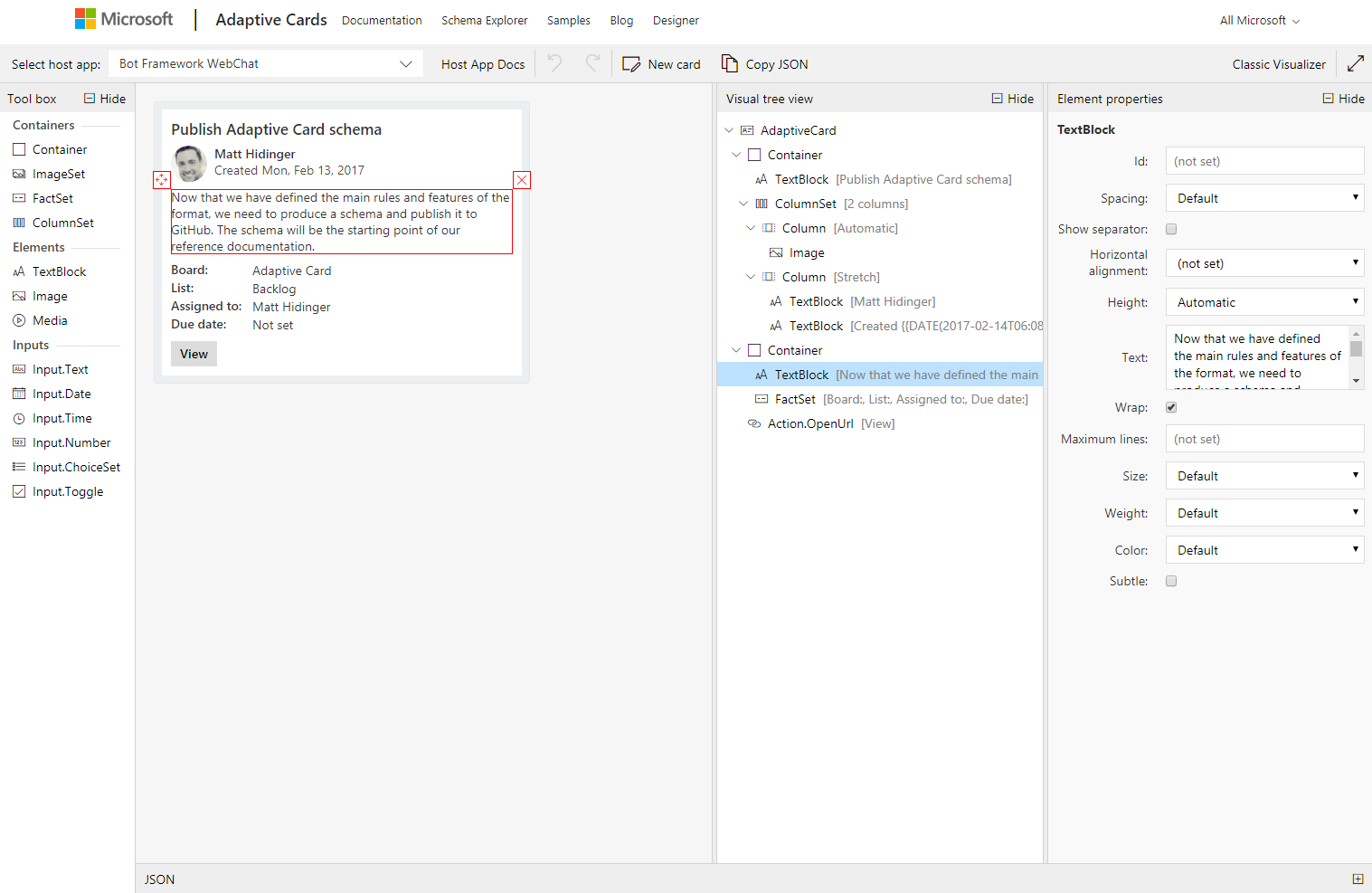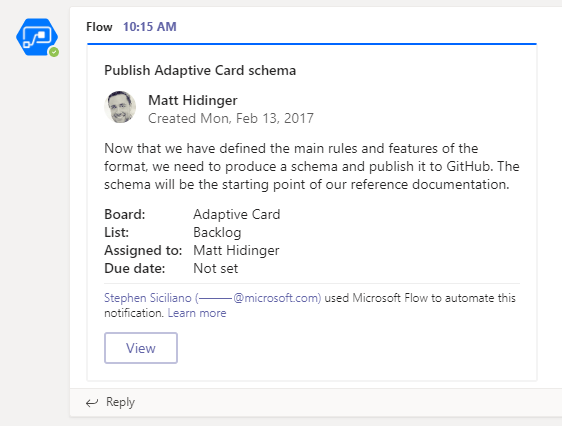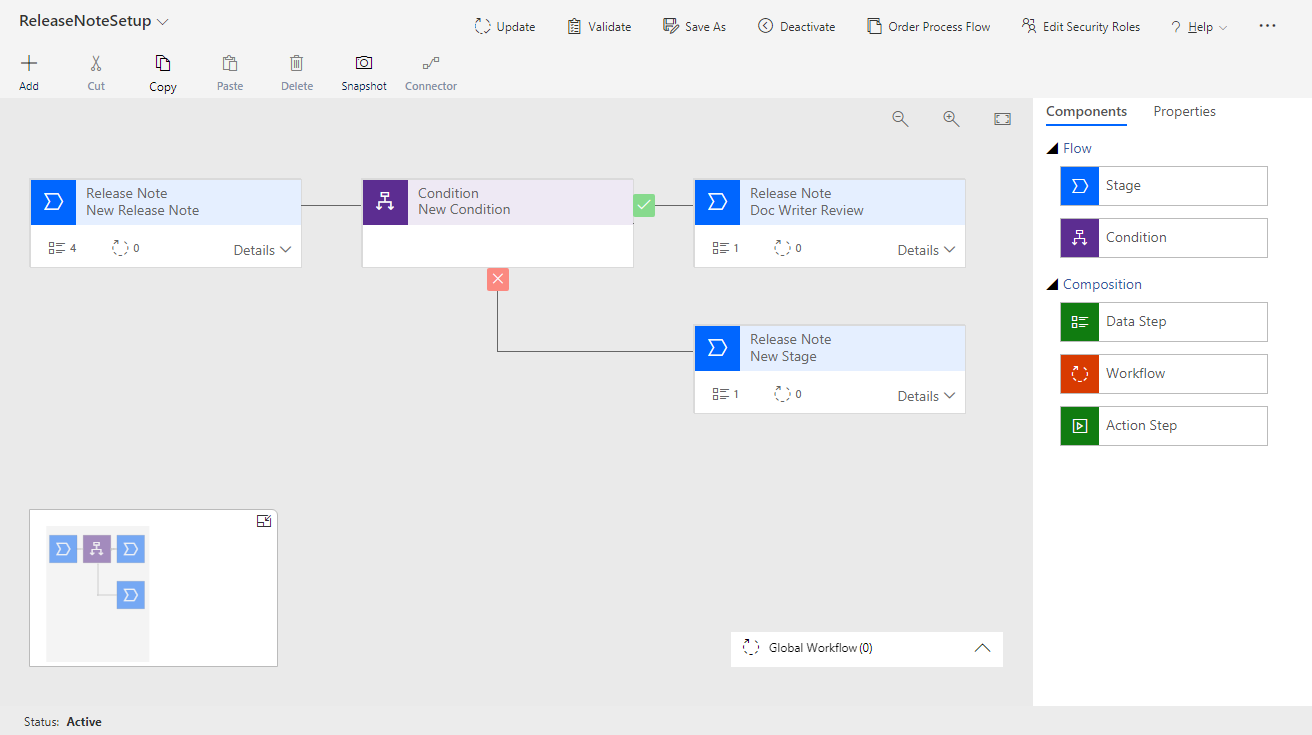Adaptive cards for Microsoft Teams, Microsoft Flow US Government now available
Adaptive cards for Microsoft Teams
You can now post your own adaptive card as the Flow bot to a channel. An adaptive card is a way to present richly formatted content directly into a teams conversation. Adaptive cards can contain components like images, graphs, richly formatted text and more. To get started, select the new action on the Microsoft Teams connector:

Adaptive cards use a common JSON format that you can use across many different channels. However, you don’t need to author this JSON by hand – you can use the rich drag-and-drop designer on the Adaptive Cards website to build your card.

Once you have added all of the elements that you want on the card, open the JSON pane at the bottom and copy everything there. Then, paste that entire content in the Message field on the action in the Flow designer. When the action runs, a nicely formatted adaptive card will appear in the Teams channel you selected:

In addition to posting an adaptive card, you can also post a simple message as a bot to a Teams channel. These messages can come from the Flow bot instead of your user account. In addition, these messages can contain @mentions of other users, so they will be notified when you post. To create an @mention you need to surround their email address or user ID with the <at> tag. For example:
Hello <at>stephen@example.com</at> - your request has been completed!Microsoft Flow US Government is generally available
Microsoft is committed to enabling government agencies to reduce the complexity of IT, meet compliance and security regulations, and turn data and insight into intelligent action – making interactions with citizens impactful and driving government efficiencies.
Agencies are adopting the cloud to store data from a multitude of sources like web traffic and business systems. Once an organization has the infrastructure for harnessing data, they also need a layer atop that data that enables them to get insights easily. That’s what the Power Platform is—a system that enables users to do three key actions on data: Analyze, Act, and Automate. Power BI, PowerApps, and Flow work together to help anyone, regardless of technical ability, drive decisions with data.
Now, Microsoft Flow for Government is generally available. Flow general availability will also land in Dynamics 365, Microsoft 365 and Office 365 in spring 2019. This environment supports compliance with US government requirements for cloud services, including FedRAMP High, and requirements for criminal justice.
Flow US Government does have different URLs, and there are some features that are not yet enabled. You can read the full details about these topics in our documentation page. To learn more about our commitments to storing data, visit the Microsoft Trust Center page for Microsoft Flow.
Six new connectors
In the past month, we have released six new connectors in Microsoft Flow:
- Ahead – Ahead is the intelligent information hub that drives engagement and communication.
- Chainpoint – Connect your data and documents to the Bitcoin blockchain so anyone can verify their integrity and timestamp.
- Document Merge – SharePoint Document and Mail Merge is the simple, fast and clean way to merge SharePoint list data into predefined Word, Excel and PowerPoint document templates with NO CODE!
- Dynamics 365 Customer Insights – Dynamics 365 Customer Insights is a cloud-based service that enables every organization to unify and understand their customer data to harness it for intelligent insights and actions.
- Projectwise Share – ProjectWise Share is an instantly available, easy to configure File Sharing Service that’s associated with a CONNECT Project. It provides CONNECT Edition applications, Cloud Services and Mobile applications the ability to save and / or consume files from a common cloud repository and CONNECTED Users an easy, secure way to share files with Team Members.
- SignNow – SignNow makes it easy to sign, send, and manage documents anywhere on any device with a simple and secure electronic signature solution.
We have also improved the connector documentation — you can now see which regions a given connector is available in. For example, not all connectors are available in Microsoft Flow US Government.
Streamlined authoring for business process flows
Finally, there are two improvements to the authoring experience of business process flows to bring them more in line with the other experiences in Microsoft Flow.
First, you no longer need to specifically opt-in a Common Data Service (CDS) entity to use it from a business process flow. Since business process flows leverage a separate entity in CDS to store the business process data, there is no longer a reason to limit business process flows to certain entities.

Second, the authoring experience now opens directly in the Microsoft Flow designer, instead of in a separate tab. Finally, the appearance of the business flow designer has been modernized to match the rest of the Microsoft Flow experience.



